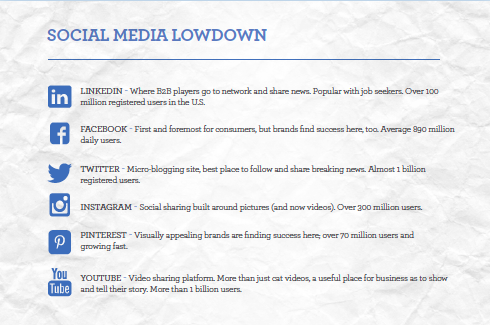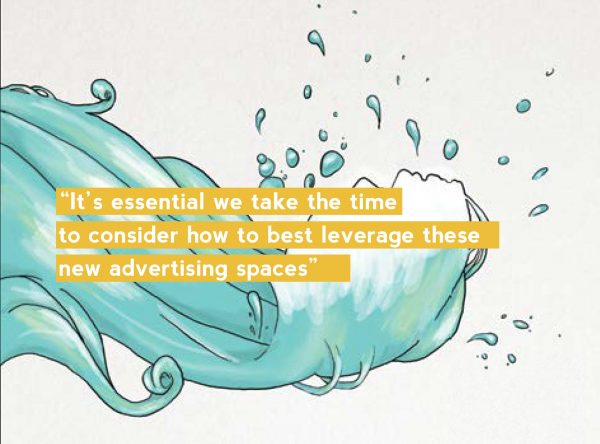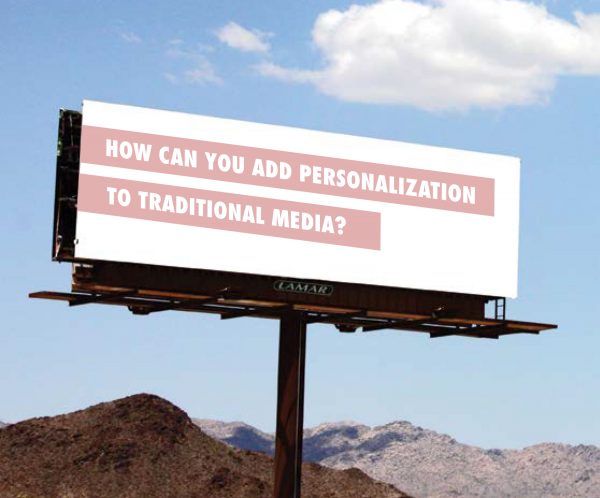February 12th, 2016
All Hail King Content

Content is king, and it remains the best way to build return on investment, show public relations’ value to the organization and express thought leadership in B2B marketing communications.
But the phrase is a bit ironic. The quote, widely attributed to former Microsoft CEO and self-proclaimed nerd, Bill Gates, often is twisted to hype simple tactics like SEO, Google Ads or Twitter feeds. While these tactics are necessary and important, they are not content. And without good content, the best tactics will fail. When thinking in terms of content for B2B communications, the key thing to remember is to give your audience content that has substance. B2B consumers are no different than B2C consumers. Both groups crave well-developed content that meets their expectations and helps them make informed decisions to satisfy their needs.
Each day, we are bombarded by thousands of messages. Even the ones that reach us oftentimes do not meet our expectations. That is because there is no depth of information or tactical engagement strategy behind them. Content with no depth is like selling fast-food-style burgers and fries in a “foodies’” market. While burgers and fries are inexpensive and can fill you up, they are not sufficiently satisfying to your customers’ niche palates.
So what is the secret recipe?
It’s not really about the recipe, but rather how the ingredients blend together. A great B2B content recipe – one that builds brand loyalty, shows thought leadership and attracts new customers – is done best with the public relations function.
PR is built to:
- Ask a lot of hard questions
- Identify target audiences (and potential audiences), as well as their attributes and needs
- Develop messages and a brand story to convey what those audiences need to see and hear
- Demonstrate a company’s expertise, thought leadership and position in the market
- Help grow the business
- Sell products or services
- Protect the reputation of the business
Keep in mind that a public relations message may not necessarily make a good Tweet or maximize SEO, but that is where your creatives and tactical specialists come into play. Content developed through the public relations function is adaptable to any social media channel and leads to the other relevant communications that B2B customers crave. Why? PR content is built with depth – the mission, foundation and key elements of the organization – not just a catchy phrase or a metatag.
Generating content in this manner engages employees, too – employees who help carry your brand messages to your current B2B customers and potential customers. And it creates an important byproduct: It helps you listen to your customers. Listening will help you satisfy customer needs and build long-lasting relationships. An additional bonus of listening is it provides access to a pipeline of competitive information to help you innovate, adapt and grow – a pipeline your competitors would love to have.
One of our clients described it best. Upon calling us in to help with a new product, she said public relations and its content development is mission critical to her company. “It ties our values, customer service, advertising, sales and internal communications together,” she said. “It is the difference maker.”
How often have we heard “we need to communicate better”? Viewing content from a public relations perspective helps you communicate better with your B2B customers and at all levels of your organization. Let it be the difference maker for you.
February 12th, 2016
Beneath the Surface of Google Analytics

There are so many considerations to take into account when planning for the rollout of a new online campaign.
Deciding on the upfront strategy, identifying the proper channels for reaching your audience, managing the content creation – it all commands significant attention. So much that arguably the most important aspect of the process can be taken for granted: measuring your campaign’s success. If you’ve run ads through a banner network or social media platform, you are no doubt familiar with reports that show the number of impressions and clicks you are receiving. But how much do you know about what people are doing after they get to your site?

If you are monitoring your site’s traffic with Google Analytics, you’re off to a great start. The default reports provide great insight to how people are using your website as a whole. However, when you start asking questions like “which creative execution is producing the most traffic?” or “how many click-throughs from my Ad Words campaign filled out the form?” you might find yourself scratching your head about how to answer these. With just a little upfront planning, you can prepare yourself to answer these questions (and many more) all inside Google Analytics. Best of all, none of this requires any changes to the code on your website. As long as the default analytics tracking code is installed, you’re set!
All this insight is unlocked via one simple, yet very powerful feature of Google Analytics: Custom Campaigns. Custom Campaigns allow you to easily identify and differentiate the sources of visitors who visit your website, ultimately enabling you to determine the most effective way to entice visitors. When properly implemented, the level of insight granted is incredible. For example, it’s possible to compare traffic and engagement generated from your newsletter on an email-by-email basis. Another practical use is differentiating your organic social media traffic from your paid promotions.
Custom Campaigns are the keystone to our advanced analytics insights, but to get the most mileage out of them, we need to make use of another feature of Google Analytics: Segments. Segments are an incredibly powerful feature that enables you to identify and isolate your site’s visitors by using rule-based criteria. Simply put, this means we can see what specific audiences (as defined by our custom campaign) are doing on our site. And we can then easily compare them to other audiences (a segment of your visitors). “Who spends more time on my site – organic search or email marketing visitors?” “How do the click-throughs reported by the ad network compare with actual measurable traffic on my site?” The answers to these questions (and so much more) are just a few clicks – and a custom segment – away.
Measuring success and then reacting to your results is the most important part of any online campaign. We’ve seen, with a little upfront planning, the insight possibilities that we can unlock using our existing toolset with no additional development resources. So make sure you’re getting the most for your advertising dollars by using Custom Campaigns and Advanced Segments in your online marketing strategy.
February 12th, 2016
The B2B Social Scene
In a recent survey from Maxus, 70 percent of business people said B2B brands don’t do a good enough job of communicating with them online.
And 86 percent were keen to see company news and content from suppliers on social media, as long as it was relevant. In other words, business audiences want you to communicate with them.
Many B2B marketers feel a level of frustration with their social efforts, particularly when they read about the successes that consumer companies are having in the social space. The fact is, social media marketing can be very effective for B2B companies, but success looks different than it does for consumer companies.
Social media can be an extremely effective tool for B2B marketers because it can help to:
- Increase brand awareness
- Humanize your company
- Establish your company as a thought leader
- Connect with prospects, clients and industry influencers
- Nurture leads
- Increase lead-conversion rate
The biggest complaint we hear has to do with low numbers of fans and followers. With B2B social media marketing, you have to understand that your universe will be smaller. And that’s not a bad thing. Focus on the key audiences that matter to you. The point isn’t to create a “Gangnam Style” viral effect or get millions of views. If your efforts help to create a lead, nurture prospects, strengthen a relationship, shorten the sales cycle or build your reputation, it’s worth way more than getting a bucketful of views.
Here are some best practices to help strengthen your social efforts:
Align content to your sales funnel, but don’t be self-centered.
Think about relevant content at every stage of the purchase process. Help bridge buyer pain points and address their decision-making criteria. Things like calculators, comparison guides and case studies can be very effective. Use the 80/20 rule to avoid being self-centered. 20 percent of your daily content should be related to your business, while the other 80 percent should be broader industry news and engagement. By sharing content other than your own, your followers will know they can rely on you to be a resource for the latest in the industry.
Find your audience.
Of course, you should follow and engage with current and potential customers, but also look broader to find the key influencers in your industry. Tools like Followerwonk, SocMetrics and WeFollow can help pinpoint influencers around particular subjects. These people can be fundamental in helping spread awareness of your brand.
Engage.
Social media is a dialog, not a monologue. So respond to questions and comments directed toward you through @ replies and comments. Use tools that allow you to monitor relevant conversations and seek opportunities to join in. Hashtags are another great way to be a part of the conversation; they give you a sense of what people are talking about and reveal questions you may be able to answer.
Analyze and audit.
Analyze how social is contributing to your bottom line. Set up your analytics to evaluate the effect of social on your website traffic – and even sales. When sharing links to your website content, tag them; this will enable you to see what channels and social campaigns are getting people to click. Tools like Buffer and Followerwonk will let you know what content is doing particularly well, or how engaging you’ve been. From there, you can tweak your program as needed.

February 12th, 2016
Interview with a B2B Social Expert – Jay Gatz
 Jay Gatz is director of digital customer experience at Emerson – a global company comprised of five business segments: Process Management, Industrial Automation, Network Power, Climate Technologies, and Commercial and Residential Solutions. Emerson’s businesses are increasingly utilizing social media channels to connect with their B2B customers.
Jay Gatz is director of digital customer experience at Emerson – a global company comprised of five business segments: Process Management, Industrial Automation, Network Power, Climate Technologies, and Commercial and Residential Solutions. Emerson’s businesses are increasingly utilizing social media channels to connect with their B2B customers.
“There’s no boilerplate for B2B social media like there would be for getting started in PR. There’s no way to know what’s right for a market and the ambiguity is overwhelming for most B2B companies. The key difference is that in social the campaign never ends. It’s one of the reasons why more companies don’t engage – it takes a major commitment of time, and once you start, you can never stop,” he said.
In spite of the uncertainties, Gatz is adamant that B2B marketers must participate. “Credibility comes from social media. If you’re not engaged (there), then you don’t have an ear on the pulse of your customers and the marketplace.”
So why is Emerson so committed to learning and engaging in this arena?
“The challenge for B2B marketers is that we all live in a connected and transparent world. The average American is exposed to hundreds of thousands of brand impressions just from the time they wake up until they get to the workplace. So you’re not just competing with the other supplier, trying to get on the approved provider list, you’re competing for mindshare with every single other marketer out there and the individuals own social network.”
In his opinion, Gatz feels that the adoption of social media in the B2B world is “happening faster than you can see. For every 60-year-old who retires, three or four 20-somethings replace them. And this is the norm for how they communicate and share information.
Some closing thoughts from Jay on social marketing for B2B companies:
- Trust that it’s not wasted effort. People are looking at it.
- If you’re scared of Twitter, use it as a voyeur. Follow competitors and customers.
- The level of honesty and transparency this space creates cannot be taken lightly. You must be at the table or risk disintermediation.
You can follow Jay Gatz on Twitter @VPJay, and check out Emerson @Emerson_news.
February 12th, 2016
The Fastest Road to Personalization
How can you quickly and easily begin the personalization process?
Many marketers are overwhelmed by the sheer volume of “big data” collected, much less knowing what to do with it. Taking the leap can feel like diving head first into a deep, dark hole. The complexity and uncertainty of it all is daunting enough to make even experienced marketers reminisce about the good old days of simple mass marketing. But we all have to move forward or get left in the dust. So here are eight fairly simple tips to get you started on your journey to more personalization.
1. Create marketing personas.
You donʼt need to be a rocket scientist to understand your customers. Study your existing customer data and create some working personas (a.k.a. profiles based on segments) that help your team better understand who your customers are and how they behave.
2. Stop sending mass emails.
Use the marketing personas that youʼve created to personalize the messaging in your emails. Send them in chunks using the language that that particular persona responds to. If you donʼt have personas, do some basic segmentation of your list based on information you have, such as location, past purchases or interests. However you break it out, youʼll probably see better results.
3. Send emails from a human,not a company.
Use the marketing personas that youʼve created to personalize the messaging in your emails. Send them in chunks using the language that that particular persona responds to. If you donʼt have personas, do some basic segmentation of your list based on information you have, such as location, past purchases or interests. However you break it out, youʼll probably see better results.
4. Create targeted landing pages geared toward different marketing personas.
If you don’t have the bandwidth to create content targeted at each of your customer personas, you should at least create targeted landing pages for your various offers. Customize the language and messaging on your landing pages to address the specific needs of that particular segment, and do this for each segment.
5. Pull audiences into the conversation.
On average, conversion rates are 105 percent higher for consumers who interact with ratings and reviews, so invite customers to leave real-time feedback. Incorporate reviews and comments throughout your Web properties.
6. Leverage social media to enhance your user profiles.
You probably already use social media in your marketing efforts, but what you may not know is that social profiles like Facebook and Twitter contain tons of user-profile data points, such as names, email addresses, interests, likes, friends, locations and more. All of this information can be passed on to third-party sites to generate tailored digital experiences. Social login facilitates this process, creating a seamless bridge between the usersʼ social media experiences and the rest of the Web.
7. Respond to prospects and customers in social media.
Don’t over-automate your marketing messages or neglect to monitor social media activity on a daily basis. Make sure a real human is tracking and responding to questions and comments in social media, and make sure they are ready to provide the best and most appropriate content and responses.
8. Use marketing automation tools to trigger campaigns based on interests.
If someone puts something in a shopping cart but doesnʼt check out, or if someone downloads a white paper focused on a specific topic, use marketing automation tools to automatically enter them into a lead-nurturing campaign that delivers content relevant to that initial interaction.
True personalization puts the customer in its lens and allows marketers to present relevant offers and messages that develop a relationship throughout the customer lifecycle. It doesnʼt happen overnight. It will take some time. So think long term. Single transactions donʼt build sustainable business, loyalty does.
February 12th, 2016
Breaking Tradition
Personalization is a prime objective of most marketers today and, as most of us know, personalization is highly achievable via digital media. But
how is traditional media keeping up with digital media in regards to personalization? How do you get that one-on-one communication in a traditionally rooted mass communication medium?
Typically, traditional media was and is about reaching the masses. With television and radio, they are taking large strides to incorporate subscription-based targeting and data for ad delivery through devices that individuals have in their homes or cars. But what about, say, outdoor? How do you personalize outdoor? How do you make it relevant to the person driving by? How do you make them remember your billboard and your brand over the 20 others that they drive by during their commutes?
The answer, is digital boards.
In order for outdoor advertising to keep up with digital mediums in terms of personalization, the old adage stands true: if you can’t beat ‘em, join ‘em. Digital billboards and out-of-home (OOH) signage are increasing in numbers. The digital signage equipment, technology, services and media itself earned a projected $13.9 billion in 2013.
And, over the next few years, they are projected to see a steady increase ranging from 4.7 to 5.6 percent, simply due to improvements in technology and offerings. For advertisers, digital billboards and OOH signage have a low cost of production, have the ability to switch creative more often, and, according to Science Applications International Corporation, drivers were slightly more likely to look at digital billboards than standard billboards and other OOH signage.
Also, more and more advertisers and outdoor companies are becoming more and more creative on how they use digital billboards. For example: dayparting – running specific ads during specific times of the day. Like Burger King running breakfast sandwich creative during the morning drive and burger creative in the afternoon. Some companies are even introducing weather-induced ads, similar to online display. When it is snowing or raining or below a certain temperature, the advertiser can run creative that’s relative to the weather. Digital billboards are also incorporating digital ties to social media, as well, like Instagram and Twitter. A well-known Ben and Jerry’s campaign incorporated Instagram posts of customers enjoying their ice cream with a certain hashtag for a chance to have their photo posted on an outdoor digital billboard in their own neighborhood.
Another great example of outdoor personalization was in 2013 when Coca-Cola used advances in digital outdoor technology during their “share a coke” campaign. I called it the “personalize a road” outdoor campaign. They used geofencing capabilities to establish when a cell phone user who downloaded Coke’s “Share a Coke” app was in proximity to the billboard. The board then served creative with his or her name on it. Can’t get more personalized than that! The campaign also sent a notification to the person’s cell phone as he or she was approaching the board, notifying that his or her name was going to be on the board ahead. This campaign created a very personal feel around the Coca-Cola brand.
These are just a few examples of how outdoor and OOH traditional media is becoming more personalized and can deliver creative, engaging, memorable one-on-one communication through a traditionally rooted format. In some cases, becoming a better, more standout medium than its other digital competitors. And, whether or not you have the budget to pull off personalization on this scale, it hopefully opens your eyes to a new realm of possibilities.
February 12th, 2016
The Power of Who, What, Where, When and Why
Why is research so important when it comes to personalization?
 I have good news and bad news regarding personalized marketing messages. Letʼs start with the bad news: you have to thoroughly know your audience first, which can cost a lot of time and money. You have to know what they are looking for and when; how they like to communicate and through which mediums; and whether or not they even trust you. The good news, however, is that you already needed to know these things for long-term marketing success. The challenge now is making all this information work together in a way that makes your audience feel special,
I have good news and bad news regarding personalized marketing messages. Letʼs start with the bad news: you have to thoroughly know your audience first, which can cost a lot of time and money. You have to know what they are looking for and when; how they like to communicate and through which mediums; and whether or not they even trust you. The good news, however, is that you already needed to know these things for long-term marketing success. The challenge now is making all this information work together in a way that makes your audience feel special,
instead of worried about privacy.
Personalization in 2014 is an extension of the 2013 marketing trend “big data.” Access to lots of integrated data is imperative to being able to most effectively deliver personalized messages. And yet, according to Allen Bonde and the Digital Clarity Group, many marketers continue to struggle with big data (i.e., what data they have, what they can do with it, how to change the data being collected, confidence in the data collected, analyzing the data, and/or acting on the data).
Big data paints a better picture of your current and prospective customers. This better picture allows for personalization. Focusing on messaging to women ages 25 to 45 is not personal. These women are waiting for brands that “get them” and understand how they are unique. A new mom has a very different perspective and needs than an empty nester. But all new moms are not equal either. They have different incomes, ethnic backgrounds, world perspectives, and desires to hear from marketers. Understanding the nuances and crafting personalized messages will delight customers and entice engagement and/or purchase. These messages will take more time to pinpoint and craft, but the return should be greater.
Imagine this, my airlineʼs frequent flyer program (and thus, the airline I use most) already knows where I fly to most often, the length of my average stay, what time of year I fly, and how far in advance I buy my tickets. This is a lot of great information. What if the program sent me a note that it is time to plan for my next trip and that my ticket will be cheaper to buy today compared to a week from now? Or what if they send me a discount code to buy my next trip ticket with them? It would be easy keep me as a customer by making my life easier. Imagine what they could do with seat preference.
Want more good news? Your audience can, and often wants to, help you deliver a personalized message. Consider Netflix and how different family members can set up individual profiles under a single account, or how Facebook mobile allows users to hide ads. Both brands allow their audience to define their personalized message and reduce frustration. Going back to the airline frequent flyer program example, what if they asked ahead of time what I would like to eat or drink during the flight? My flight could be nicer and the jobs of flight attendants easier if they already knew what to carry down the aisle. Even better, what if I never ask for a drink because I always bring a bottle of water with me and then, after refusing so many beverages, I get an airport voucher for the day I travel to pick up a bottle on them? I just helped them personalize my experience and strengthen my loyalty.
Ultimately, your audience wants to know you are thinking about them and a generalized message is no longer good enough. Dig deeper into how they think and feel and allow them to help you to find success with personalization.
Reference: Allen Bonde, 2013. “Thinking Small: Bringing the Power of Big Data to the Masses.” Digital Clarity Group.
February 12th, 2016
A New Wave of Online Ads
How can personalization help you see more success with your digital advertising?
Personalization on the Internet is expected at this point. We are able to choose what people/sources we want to “follow” on social services. We can pick and choose what we want to subscribe to. Major network news sites can be filtered to your preference with yet another simple signup, or even by quickly connecting to your Facebook. This type of feature set is so inherit to online experience that it is now the rule over the exception.

For years we have each been crafting the version of the Internet we’re interested in seeing, and, for many of us, probably sequestering ourselves to it (aside from those fun links our friends share). We happily create our own walled gardens, and why wouldn’t we? Entitlement is a big thing on the Internet – see what you want to see and be heard on what you are passionate about. And we’ve been doing this long enough that we can spot a “traditional” ad from a mile away. A recent survey found four in five people actively ignore ads on Facebook. There are similar numbers on the app side of things, with 88 percent of people ignoring mobile ads and finding them annoying or intrusive.
Objectively looking at these numbers and then comparing “ignore rates” in other mediums (i.e., TV at 14 percent and radio at 7 percent), one might conclude it’s just not worth advertising on the Internet. People obviously don’t agree with that, as Internet advertising revenue is at an all-time high at $10.7 billion in the third quarter of 2013 (that’s 15 percent higher than the previous quarter). So what’s going on here? Are we throwing away money? Depending on how you’re spending those dollars, and how you measure success, you may very well be. People probably aren’t going to be too interested in filling out a contact form after tapping an ad in their Pandora app, but they might be more inclined to do so coming in from either a paid or organic search on their desktop.
As advertisers, we have more than enough ways to target our demographics of interest on every system that will sell you ads. Finding the people we’re interested in is no longer the problem; it’s getting them to even notice we’re waving our arms at them! With more and more consumers able to “tune out” traditional online ads, we’re seeing interesting experimentation in the delivering of ads – blurring the lines between content
and advertisement. Facebook, for example, is integrating ads into your newsfeed that have nearly no layout difference than the content you opted into consuming. Buzzfeed has versions of articles that are “presented by” a brand of choice, and often these articles are subtly themed with the brand’s identity.
We’re in a time now where the one-size-fits-all landing page really shouldn’t be the only tool in your online marketing belt. As more and more popular sites move away from traditional banner advertising and create experiences unique to their systems, it’s essential we take the time to consider how to best leverage these new advertising spaces, as well as whether or not they are even relevant to consider. For example, there are tons
of brands that have no business being on Pinterest, but, when it was the hot new service, everyone had to have a page of their own on the site.
Pragmatic reasoning aside, when the Web offers us so many sub mediums and methods of engagement, experimentation should be encouraged. If we don’t, we’ll be lamenting the days when “only” 88 percent of people ignored our mobile advertising.
February 8th, 2016
Personalization is the Buzzword of 2014 for Marketers
 Itʼs far more than dropping an addresseeʼs name into a direct mail letter. Itʼs not including <first_name> and <company> field into an email. The overwhelming amount of data that exists for each one of us can enable savvy marketers to deliver a message that is not just addressed to a recipient by a correct name, but addressed by true understanding of our needs, desires, dreams, and behaviors.
Itʼs far more than dropping an addresseeʼs name into a direct mail letter. Itʼs not including <first_name> and <company> field into an email. The overwhelming amount of data that exists for each one of us can enable savvy marketers to deliver a message that is not just addressed to a recipient by a correct name, but addressed by true understanding of our needs, desires, dreams, and behaviors.
The sheer volume of data available on each one of us has spawned another buzzword, “big data,” and itʼs an apt moniker. Buying habits, location, abandoned e-commerce shopping carts, web page youʼve visited, how long you linger in a store and what direction you shop – itʼs all available, and not just to the NSA.
What was long considered the Holy Grail of personalized marketing —addressable TV commercials, where a specific TV ad is delivered to a specific household — is a reality, with over 42 million households reachable through DirectTV, Cablevision, and Dish Network, among others, and the number is expected to reach 50 million by year end. VW is among the marketers testing the waters here, bringing TV ads directly to whom they believe to be their best prospects.
Unhappy with the service you received at the hardware store? Tweet about it, and you may hear from the retailer with a coupon to come back in. Hotel room in disarray? Post a picture of it on Facebook and publicly shame them, then donʼt be surprised if the manager reaches out to you with an offer to correct the problem. And now youʼre in their database.
The upside to all of this knowledge is that marketers can deliver highly relevant messages to customers. Visit a website to browse for air travel, and expect to see ads for travel deals pop up on every website you visit for the next month. (For those of us who do research for clients, it results in some very unusual ads.)
Itʼs like Howard Gossage said: “Nobody reads ads. People read what interests them. Sometimes itʼs an ad.” Personalization in both message and delivery is how we transform ads into something interesting and engaging.
Thereʼs a dark side to personalized marketing, however, and marketers must be careful to not cross a boundary and become too “big brother” in their efforts. Many consumers are uncomfortable knowing just how much detailed information marketers have on them. They know where youʼve been shopping. They know what TV shows you watch, what you buy, what you donʼt buy, what your neighbors buy, and how often you buy it. Amazon recently filed a patent for “Anticipatory Shipping” wherein they will ship you things you want before you know you want them. How much information is too much information?
A few years ago, Target got in trouble for sending coupons for baby items to a young woman they determined was expecting based on her purchases. She was 16, and itʼs how her father learned she was pregnant. And recently, Bank of America sent a credit card offer addressed to “Lisa is a slut machine.” Officemax sent a promotional offer addressed to “Mike Seay, daughter killed in car crash.”
The lessons? Tread carefully. Handled well, a personalized marketing message delivered to a targeted prospect at a relevant time is the most effective and efficient thing you can do. But itʼs probably not a good idea to let customers know exactly how much you know about them.
Howard Gossage, one of the all-time greatest and least known of the advertising greats. Read “The Book of Gossage” to learn more.
January 20th, 2016
Services
Integrated Marketing Solutions that Fit Your Needs
As a full-service advertising and marketing agency, our capabilities stretch across all disciplines – Creative, Digital, Paid Media, PR, Social and Content. Each department works in tandem with one another, communicating and strategizing together in order to create omni-channel marketing solutions that use your dollars efficiently, generate real results and deliver strong ROI. And while each of our marketing solutions varies from client to client, two things remain the same: Everything we do is rooted in strategy, and we always start with a full understanding of your business objectives so we can meet or exceed your goals.
Here’s a full overview of the services we provide at Bozell:



